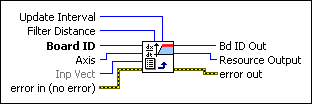Load Velocity Filter ParameterSets the velocity Filter Time Constant for the digital single-pole lowpass filter used to average the instantaneous axis velocity.
| Device Compatibility
|
 |
Update Interval is the maximum velocity update period in ms. The range for this parameter is 1 to 2,500 ms. | ||||||
 |
Filter Distance is the number of position changes in counts/steps necessary for a velocity to be reported. The range for this parameter is from 0 to 1,000 counts/steps. | ||||||
 |
Board ID is a unique number assigned by Measurement & Automation Explorer (MAX) used to send and receive commands and data to or from a specific NI motion controller. | ||||||
 |
Axis is the axis to configure. | ||||||
 |
Inp Vect
contains the distance and interval parameters that are the source of the data for this VI.
Available input vectors include immediate (0xFF), variable (0x01 through 0x78), or indirect variable (0x81 through 0xF8). Refer to Input and Return Vectors for more detailed information. |
||||||
 |
error in (no error) describes error conditions that occur before this VI
runs. The default input of this cluster is no error. If an
error already occurred, this VI returns the value of error in in
error out. The VI runs normally only if no incoming error exists.
Otherwise, the VI passes the error in value to error
out. The error in cluster contains the following parameters:
|
||||||
 |
Bd ID Out is provided for flow control. You can string together NI-Motion VIs by wiring the Bd ID Out terminal of one VI to the Board ID terminal of the next VI. | ||||||
 |
Resource Output is the Axis, Vector Space, ADC, or Encoder you wired into the VI. Use Resource Output to pass the resource to another VI and/or to display information about the device. | ||||||
 |
error out contains error information. If error in
indicates an error, error out contains the same error information.
Otherwise, it describes the error status that this VI produces.
|
Using This VI
This VI configures the internal filter for velocity reporting. The reported velocity can oscillate due to feedback quantization error, noise, and jittery systems, rendering the data useless. You can apply a filter over multiple data samples to calculate an average velocity that reflects the actual system behavior. This filter is represented by Filter Distance. The larger the Filter Distance, the more position changes accumulate to perform velocity calculation. This is usually better for a noisy system.
A large Filter Distance can introduce a longer delay in velocity reporting as the position changes accumulate. To limit this delay and sluggish data reading, specify a minimum update interval using the Update Interval parameter. The axis velocity is updated within this update interval if the Filter Distance requirement is not met.
 |
Note Velocity quantization noise is a measurement-only phenomenon and does not affect the ability of the motion controller to accurately control velocity and position during a move. |
Remarks
This section includes information about how the behavior of this VI differs among the controllers that support it.
NI SoftMotion Controller Considerations
The following list includes considerations you must make when you are using this VI with the NI SoftMotion Controller:
- For the Inp Vect parameter, the NI SoftMotion Controller supports only the immediate return vector (0XFF).






